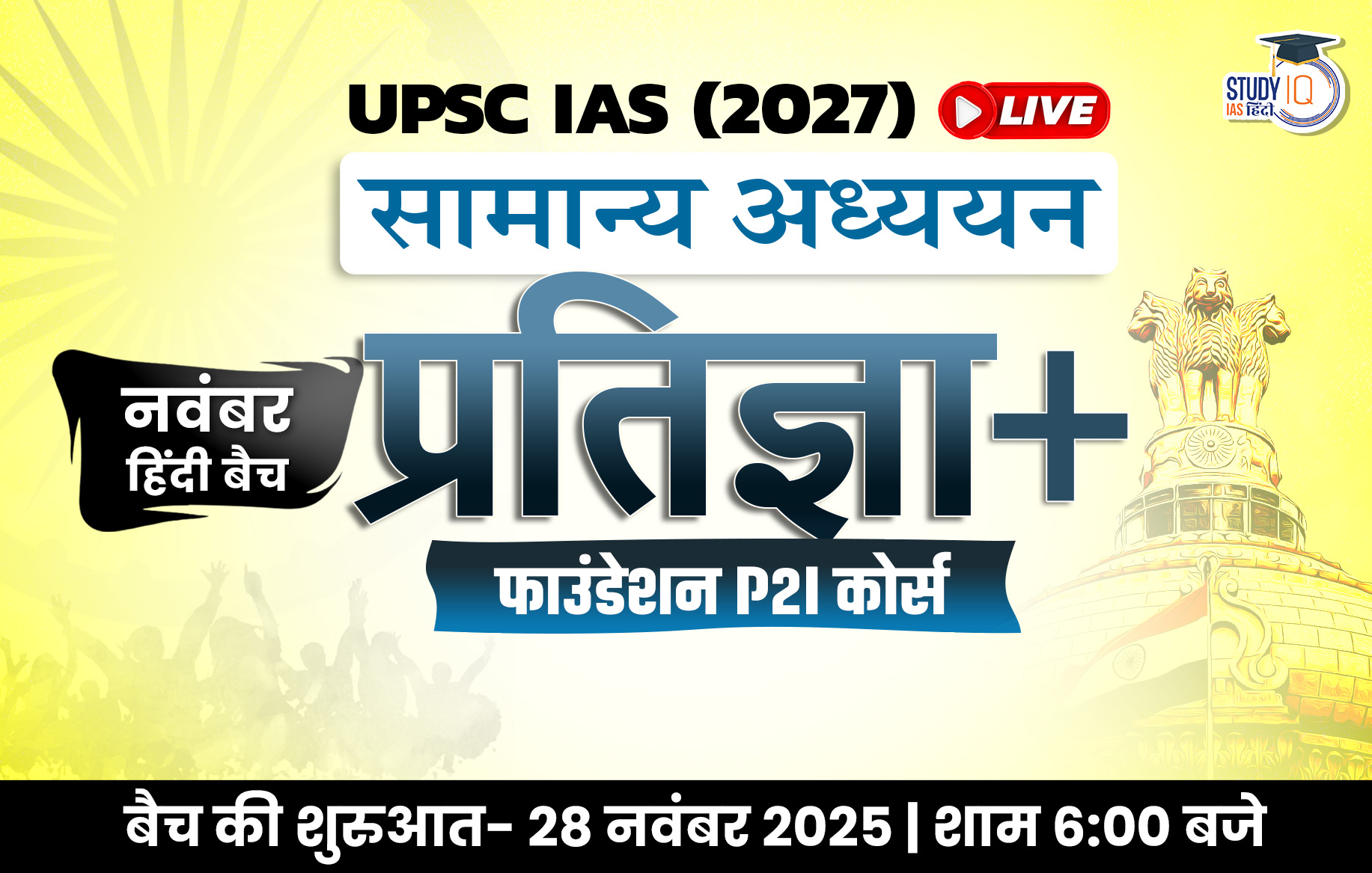Daily Quiz 18 August 2025
Quiz-summary
0 of 5 questions completed
Questions:
- 1
- 2
- 3
- 4
- 5
Information
- Click on – ‘Start Quiz’ button
- Solve Questions
- Click on ‘Next’ button
- Click on ‘Finish Quiz’ button
- Now click on ‘View Questions’ button – here you will see solutions and links.
- The test contains a total of 5 questions.
- Click on the most appropriate option to mark it as your answer.
- You will be awarded Two marks for each correct answer.
- You can change your answer by clicking on some other option.
- A Number list of all questions appears at the top side of the screen.
- You can access the questions in any order by clicking on the question number given on the number list.
- You can use rough sheets while taking the test.
- Do not use calculators, log tables, dictionaries, or any other printed/online reference material during the test.
- Do not click the button “Finish Quiz” before completing the test. A test once submitted cannot be resumed.
You have already completed the quiz before. Hence you can not start it again.
Quiz is loading...
You must sign in or sign up to start the quiz.
You have to finish following quiz, to start this quiz:
- 1
- 2
- 3
- 4
- 5
- Answered
- Review
-
Question 1 of 5
1. Question
1 pointsQ1. Consider the following statements:
Statement I: Civic engagement in health governance leads to improved accountability, service uptake, and democratic participation.
Statement II: Current health governance platforms in India, such as Village Health Sanitation and Nutrition Committees (VHSNCs), are fully functional and effectively engage marginalized communities.
Statement III: Structural barriers such as low health rights awareness and social hierarchies limit meaningful community participation.
Which one of the following is correct in respect of the above statements?
Correct
Answer: (a)
Explanation:
Statement I is correct because active civic engagement in health governance improves:
Accountability: Citizens can track and question health service delivery, ensuring funds and schemes are effectively used.
Service uptake: Trust between communities and health workers increases usage of preventive and curative services.
Democratic participation: People’s involvement affirms their rights and helps decentralize power away from bureaucratic or medical elites.
Responsiveness and equity: Local input tailors services to cultural and social needs and counters elite capture.
Statement II is incorrect because despite existence of formal governance platforms like Village Health Sanitation and Nutrition Committees (VHSNCs) and Rogi Kalyan Samitis, many of these suffer from:
Irregular or no meetings.
Poor coordination between sectors (health, nutrition, sanitation).
Underutilisation of allocated untied funds.
Inadequate inclusion of marginalized groups (women, rural poor, minorities).
Lack of capacity and awareness among citizens to participate meaningfully.
Statement III is correct as several structural barriers limit engagement:
Low public awareness of health rights and governance mechanisms.
Deep-rooted social hierarchies marginalize voices of women, tribal groups, and the poor.
Lack of civic literacy on how to engage with governance processes.
Administrative mindsets treating citizens as passive beneficiaries rather than partners.
Thus, Statements I and III are true while Statement II is false. Option (a) is correct.Incorrect
Answer: (a)
Explanation:
Statement I is correct because active civic engagement in health governance improves:
Accountability: Citizens can track and question health service delivery, ensuring funds and schemes are effectively used.
Service uptake: Trust between communities and health workers increases usage of preventive and curative services.
Democratic participation: People’s involvement affirms their rights and helps decentralize power away from bureaucratic or medical elites.
Responsiveness and equity: Local input tailors services to cultural and social needs and counters elite capture.
Statement II is incorrect because despite existence of formal governance platforms like Village Health Sanitation and Nutrition Committees (VHSNCs) and Rogi Kalyan Samitis, many of these suffer from:
Irregular or no meetings.
Poor coordination between sectors (health, nutrition, sanitation).
Underutilisation of allocated untied funds.
Inadequate inclusion of marginalized groups (women, rural poor, minorities).
Lack of capacity and awareness among citizens to participate meaningfully.
Statement III is correct as several structural barriers limit engagement:
Low public awareness of health rights and governance mechanisms.
Deep-rooted social hierarchies marginalize voices of women, tribal groups, and the poor.
Lack of civic literacy on how to engage with governance processes.
Administrative mindsets treating citizens as passive beneficiaries rather than partners.
Thus, Statements I and III are true while Statement II is false. Option (a) is correct. -
Question 2 of 5
2. Question
1 pointsWith reference to groundwater contamination in India, consider the following pairs:
Contaminant Major Source 1. Nitrates Overuse of chemical fertilizers and septic tank leakage 2. Arsenic Discharge from pesticide manufacturing units 3. Fluoride Naturally occurring geogenic sources 4. Uranium Phosphate fertilizers and over-extraction of groundwater How many of the pairs given above are correctly matched?
Correct
Answer: C
Explanation:
- Pair 1 – Correct: Nitrates in groundwater are commonly caused by excessive use of nitrogen-based fertilizers, leakage from septic tanks, and untreated sewage. Especially in agricultural areas, nitrate contamination is widespread due to runoff and leaching.
- Pair 2 – Incorrect: While industrial effluents (including pesticide units) can release arsenic, the primary source of arsenic in Indian groundwater is geogenic (natural origin), particularly in the Ganga–Brahmaputra plains. It leaches into groundwater from arsenic-rich alluvial sediments due to reduction of iron oxides in aquifers.
- Pair 3 – Correct: Fluoride contamination in India is primarily geogenic, coming from fluoride-bearing minerals in rocks and soils. It dissolves into groundwater in arid and semi-arid regions with alkaline pH and high temperatures.
- Pair 4 – Correct: Uranium contamination is increasingly being reported in Indian states like Punjab. It is linked to geogenic sources, but over-extraction of groundwater (which mobilizes uranium from aquifer rocks) and use of phosphate fertilizers (which may contain uranium as an impurity) are considered contributing factors.
Incorrect
Answer: C
Explanation:
- Pair 1 – Correct: Nitrates in groundwater are commonly caused by excessive use of nitrogen-based fertilizers, leakage from septic tanks, and untreated sewage. Especially in agricultural areas, nitrate contamination is widespread due to runoff and leaching.
- Pair 2 – Incorrect: While industrial effluents (including pesticide units) can release arsenic, the primary source of arsenic in Indian groundwater is geogenic (natural origin), particularly in the Ganga–Brahmaputra plains. It leaches into groundwater from arsenic-rich alluvial sediments due to reduction of iron oxides in aquifers.
- Pair 3 – Correct: Fluoride contamination in India is primarily geogenic, coming from fluoride-bearing minerals in rocks and soils. It dissolves into groundwater in arid and semi-arid regions with alkaline pH and high temperatures.
- Pair 4 – Correct: Uranium contamination is increasingly being reported in Indian states like Punjab. It is linked to geogenic sources, but over-extraction of groundwater (which mobilizes uranium from aquifer rocks) and use of phosphate fertilizers (which may contain uranium as an impurity) are considered contributing factors.
-
Question 3 of 5
3. Question
1 pointsThe Great Barrier Reef has been in the news due to which of the following reasons?
Correct
Answer: B
Explanation:
- The Great Barrier Reef has experienced a sharp decline in hard coral cover, primarily due to:
- Heat stress from rising ocean temperatures,
- Frequent cyclones, and
- Outbreaks of crown-of-thorns starfish, which feed on coral.
- This decline is considered the worst in nearly four decades, posing a serious threat to biodiversity.
- Option A is incorrect because it is still listed as a UNESCO World Heritage Site.
- Option C is factually incorrect – the reef is undergoing bleaching, not full recovery.
- Option D is a distractor; there’s no such designation as a carbon sink for marine sites under UNFCCC.
Incorrect
Answer: B
Explanation:
- The Great Barrier Reef has experienced a sharp decline in hard coral cover, primarily due to:
- Heat stress from rising ocean temperatures,
- Frequent cyclones, and
- Outbreaks of crown-of-thorns starfish, which feed on coral.
- This decline is considered the worst in nearly four decades, posing a serious threat to biodiversity.
- Option A is incorrect because it is still listed as a UNESCO World Heritage Site.
- Option C is factually incorrect – the reef is undergoing bleaching, not full recovery.
- Option D is a distractor; there’s no such designation as a carbon sink for marine sites under UNFCCC.
-
Question 4 of 5
4. Question
1 pointsWith reference to the PAHAL (Pratyaksh Hanstantrit Labh) scheme, consider the following statements:
- It was launched to eliminate middlemen by directly transferring LPG subsidies to consumers’ bank accounts.
- It is applicable only to those beneficiaries who have Aadhaar-linked bank accounts.
- The scheme is implemented by the Ministry of Petroleum and Natural Gas.
- Households with an annual income exceeding ₹10 lakh are not eligible for subsidy under this scheme.
How many of the statements given above are not correct?
Correct
Answer: A
Explanation:
- Statement 1 – Correct: The PAHAL scheme aims to prevent diversion and eliminate middlemen by transferring the LPG subsidy directly into the bank accounts of eligible consumers, ensuring transparency.
- Statement 2 – Incorrect: While Aadhaar-linked accounts are supported, the scheme also works for non-Aadhaar-linked bank accounts, making it more inclusive.
- Statement 3 – Correct: The Ministry of Petroleum and Natural Gas is the implementing authority of the PAHAL scheme.
Statement 4 – Correct: Households where the combined taxable income of the applicant and spouse exceeds ₹10 lakh in the previous financial year are not eligible for subsidy under this scheme.
Incorrect
Answer: A
Explanation:
- Statement 1 – Correct: The PAHAL scheme aims to prevent diversion and eliminate middlemen by transferring the LPG subsidy directly into the bank accounts of eligible consumers, ensuring transparency.
- Statement 2 – Incorrect: While Aadhaar-linked accounts are supported, the scheme also works for non-Aadhaar-linked bank accounts, making it more inclusive.
- Statement 3 – Correct: The Ministry of Petroleum and Natural Gas is the implementing authority of the PAHAL scheme.
Statement 4 – Correct: Households where the combined taxable income of the applicant and spouse exceeds ₹10 lakh in the previous financial year are not eligible for subsidy under this scheme.
-
Question 5 of 5
5. Question
1 pointsRecently discovered Ni-Cu-PGE sulphide mineralisation in India is significant due to which of the following factors?
- It includes metals essential for India’s clean energy and electric vehicle sectors.
- It will reduce India’s dependency on imports of strategic and critical minerals.
- It was discovered in the western region of Rajasthan, near the Thar Desert.
Select the correct answer using the code below:
Correct
Answer: A
Explanation:
- Statement 1 – Correct:
Nickel, Copper, and Platinum Group Elements (PGE) are key components in green technologies:- Nickel is used in EV batteries (especially lithium-nickel-cobalt formulations).
- Copper is essential for electrical wiring, solar panels, and wind turbines.
- PGEs like platinum and palladium are critical for catalytic converters and hydrogen fuel cells.
- Statement 2 – Correct:
India currently imports most of its Ni, Cu, and PGE needs. The discovery in Mahasamund district, Chhattisgarh, represents a step toward domestic sourcing of these strategic and critical minerals, aligning with the government’s Critical Minerals Strategy and net-zero targets.
Statement 3 – Incorrect:
The discovery occurred in Chhattisgarh (Central India), not Rajasthan or near the Thar Desert. The confusion may arise because both regions are mineral-rich, but the actual location is in the Deccan geological belt.Incorrect
Answer: A
Explanation:
- Statement 1 – Correct:
Nickel, Copper, and Platinum Group Elements (PGE) are key components in green technologies:- Nickel is used in EV batteries (especially lithium-nickel-cobalt formulations).
- Copper is essential for electrical wiring, solar panels, and wind turbines.
- PGEs like platinum and palladium are critical for catalytic converters and hydrogen fuel cells.
- Statement 2 – Correct:
India currently imports most of its Ni, Cu, and PGE needs. The discovery in Mahasamund district, Chhattisgarh, represents a step toward domestic sourcing of these strategic and critical minerals, aligning with the government’s Critical Minerals Strategy and net-zero targets.
Statement 3 – Incorrect:
The discovery occurred in Chhattisgarh (Central India), not Rajasthan or near the Thar Desert. The confusion may arise because both regions are mineral-rich, but the actual location is in the Deccan geological belt.
Results
0 of 5 questions answered correctly
Your time:
Time has elapsed
You have reached 0 of 0 points, (0)
| Average score |
|
| Your score |
|
Categories
- Not categorized 0%
| Pos. | Name | Entered on | Points | Result |
|---|---|---|---|---|
| Table is loading | ||||
| No data available | ||||
Sharing is caring!


 Daily Quiz 18 September 2025
Daily Quiz 18 September 2025

























